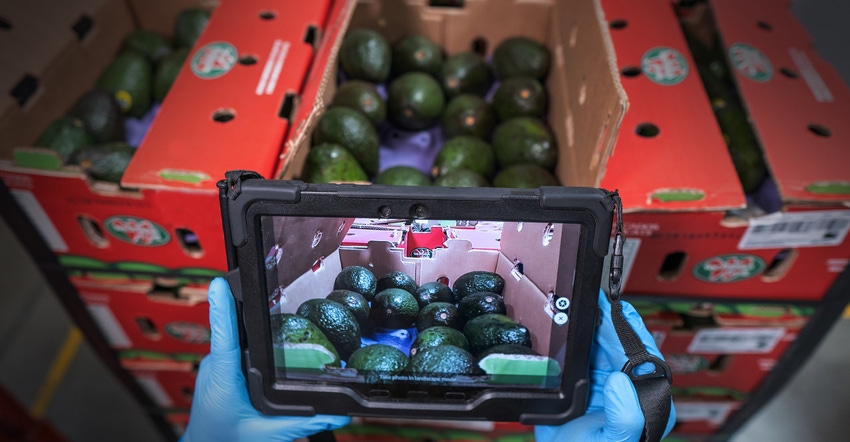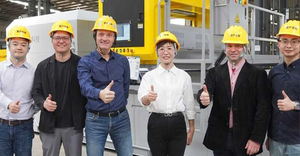Fresh produce travel along a vast supply chain, and when it gets wasted along the path from field to retailer it’s typically because of insufficient monitoring of quality and practices. When distributors reject loads, perhaps because produce are overripe, underripe, or bruised, packers and growers feel the financial pain. Up to 40% of the post-harvest food supply is lost or wasted at a cost of $160 billion annually in the United States alone.

Fresh produce travel along a vast supply chain, and when it gets wasted along the path from field to retailer it’s typically because of insufficient monitoring of quality and practices. When distributors reject loads, perhaps because produce are overripe, underripe, or bruised, packers and growers feel the financial pain. Up to 40% of the post-harvest food supply is lost or wasted at a cost of $160 billion annually in the United States alone.
Then there are the obvious environmental ramifications born from landfilling or burning rotting organics.
AgroFresh has a tool to help mitigate these casualties, which combines artificial intelligence (AI), GPS, and other technical capabilities to monitor quality and identify and alert of potential problems early. The idea is for growers and some of their supply chain partners to be able to take proactive measures.
FreshCloud, as it’s branded, is a digital platform that enables growers and packers to answer key questions throughout production, and to use data to help make decisions on produce quality, harvest timing, packing, storage, and market conditions.
“We have an audit trail from the growing field to receiving docks to the final point of distribution. When there’s a breakdown, the platform provides visibility to see where it happened along the supply chain, and growers are informed in real time so they can make operational changes to prevent rejects,” says Kim Bui, global head, FreshCloud Infrastructure and Analytics at AgroFresh.
AgroFresh came out of Dow AgroSciences over two decades ago and launched its flagship brand SmartFresh, a post-harvest technology that slows the ripening of produce to help extend shelf-life and minimize waste.
“Our scientists working across the globe took all the knowledge learned about produce behavior over those 20 years and put it into a digital platform,” says Bui.
FreshCloud runs on a mobile app or tablet and has three functions: Harvest, Storage, and Inspection.
Harvest monitors processes and conditions in the orchard and tracks the lifecycle of fruit, monitoring maturity progression and informing harvest timing.
Storage monitors inventory that may be kept in facilities for extended periods, watching out for issues to reduce waste and help ensure quality is intact when it’s distributed.
Inspection, the flagship application, tracks all quality parameters, showing how fruit is evolving in the orchard, with features to streamline in-field inspections and help simplify communications within an operation.
Inspectors open the app, see key inspection points, and fill out an electronic questionnaire to provide information on their observations. They take pictures of the trees, and the images and text data are imported into a portal and shared across multiple collaborators who can view results generated from analytics. Users can elect to give access to the data to whomever they chose.
Inspectors can look at how much fruit is on the tree and the color of the fruit—customers pay for bright colors especially apples, so with consistency in color they can sell for a higher price, according to Bui.
The AI capabilities enable measurement of fruit size at a particular date and time and at a given grower location.
“Before, someone had to measure [produce] size and write on a notepad. We capture this and other information seamlessly on the app and can analyze the data in visual form,” Bui says.
An algorithm calculates the number of buds on a tree based on the images captured, which provides a representation of how the orchard is progressing and helps inform the future harvest window
“We know the bloom date because it’s embedded in the picture. We know location because of GPS. And we get more information because we have a note section to type observations such as if there is insect infestation or information about pruning,” Bui says.
Orchardists return to the same locations through the season and capture updated information.
“So, we are building a full visual of the fruit from bloom to when it is harvested … we can connect exogenous data to create a story on the progression of fruits’ behavior,” Bui says.
The idea is to provide details in an easily accessible, streamlined format that can support customers in making the right decisions.
“We try and organize information and empower growers, packers, and shippers so they have what they need to be able to ship what Cosco or Albertson or Chipotle need, because at the end of the day if they get fruit that is on spec and on time, they can sell it. It doesn’t get thrown away,” Bui says.
Starr Ranch Growers’ Thomas Hale, director of Production, Supply and QC, says FreshCloud’s Inspection app helps keep multiple members of its team in the loop.
“We are able to quickly gather points of data from all quality-related areas of our operations and consolidate them to deliver real-time information to warehouse personnel, production staffs, and others. Our quality control staff is able to perform inspections at receiving, packing, and shipping with the AgroFresh app,” he says.
The Tennessee-based fruit grower, packer, and shipper has also been able to consolidate points of entry such as inbound quality control to put together an estimated crop size and grade breakdown The information is forwarded to the marketing and sales staff to help strategize movement and reduce shrink.
Bui believes the food industry will increasing rely on data in its operations – that data-augmented pre- and post-harvest practices, in particular will play a leading role in maximizing value by integrating various data sets affecting fruit quality (fruit maturity, weather data, harvest practices, sanitation, cooling, and storage decisions).
“Data will become one of our most valuable assets, helping the industry manage waste reduction, food safety, and sustainability on a global scale,” he says.
“The industry will pay as much attention to ‘data farming,’ growing and cultivating descriptive and predictive analytics with as much care and attention as growing high-quality produce.
About the Author(s)
You May Also Like




